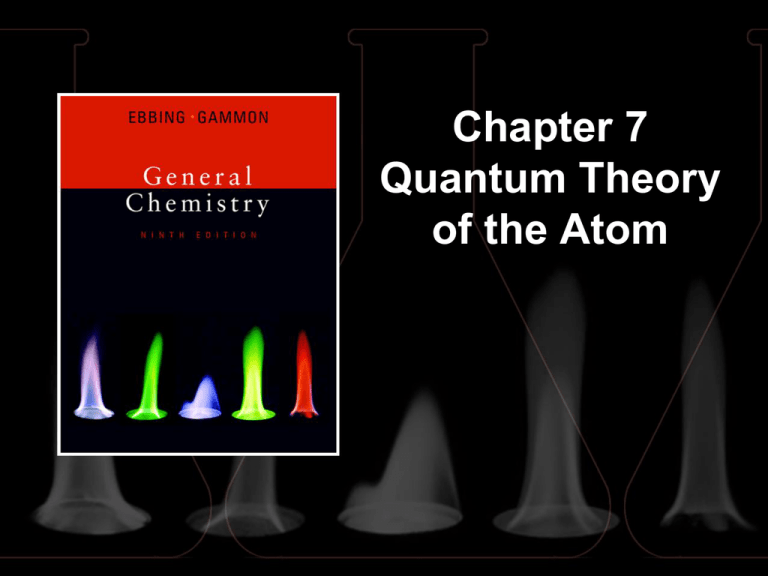
Chapter 7
Quantum Theory
of the Atom
Contents and Concepts
Light Waves, Photons, and the Bohr Theory
To understand the formation of chemical bonds,
you need to know something about the electronic
structure of atoms. Because light gives us
information about this structure, we begin by
discussing the nature of light. Then we look at the
Bohr theory of the simplest atom, hydrogen.
1. The Wave Nature of Light
2. Quantum Effects and Photons
3. The Bohr Theory of the Hydrogen Atom
Copyright © Houghton Mifflin Company. All rights reserved.
7|2
Quantum Mechanics and Quantum Numbers
The Bohr theory firmly establishes the concept of
energy levels but fails to account for the details of
atomic structure. Here we discuss some basic
notions of quantum mechanics, which is the theory
currently applied to extremely small particles, such
as electrons in atoms.
4. Quantum Mechanics
5. Quantum Numbers and Atomic Orbitals
Copyright © Houghton Mifflin Company. All rights reserved.
7|3
A wave is a continuously repeating change or
oscillation in matter or in a physical field.
Light is an electromagnetic wave, consisting of
oscillations in electric and magnetic fields traveling
through space.
Copyright © Houghton Mifflin Company. All rights reserved.
7|4
A wave can be characterized by its wavelength
and frequency.
Wavelength, symbolized by the Greek letter
lambda, l, is the distance between any two
identical points on adjacent waves.
Copyright © Houghton Mifflin Company. All rights reserved.
7|5
Frequency, symbolized by the Greek letter nu, n,
is the number of wavelengths that pass a fixed
point in one unit of time (usually a second). The
unit is 1/S or s-1, which is also called the Hertz (Hz).
Copyright © Houghton Mifflin Company. All rights reserved.
7|6
Wavelength and frequency are related by the wave
speed, which for light is c, the speed of light, 3.00
x 108 m/s.
c = nl
The relationship between wavelength and
frequency due to the constant velocity of light is
illustrated on the next slide.
Copyright © Houghton Mifflin Company. All rights reserved.
7|7
When the
wavelength is
reduced by a
factor of two,
the frequency
increases by
a factor of
two.
Copyright © Houghton Mifflin Company. All rights reserved.
7|8
?
What is the wavelength of blue light
with a frequency of 6.4 × 1014/s?
n = 6.4 × 1014/s
c = 3.00 × 108 m/s
c = nl so
l = c/n
m
3.00 x 10
c
s
λ
n
14 1
6.4 x 10
s
8
l = 4.7 × 10-7 m
Copyright © Houghton Mifflin Company. All rights reserved.
7|9
The range of frequencies and wavelengths of
electromagnetic radiation is called the
electromagnetic spectrum.
Copyright © Houghton Mifflin Company. All rights reserved.
7 | 10
One property of waves is that they can be
diffracted—that is, they spread out when they
encounter an obstacle about the size of the
wavelength.
In 1801, Thomas Young, a British physicist,
showed that light could be diffracted. By the early
1900s, the wave theory of light was well
established.
Copyright © Houghton Mifflin Company. All rights reserved.
7 | 11
Quantum Effects and Photons
Planck’s Quantization of Energy (1900)
– According to Max Planck, the atoms of a solid
oscillate with a definite frequency, n.
– He proposed that an atom could have only certain
energies of vibration, E, those allowed by the
formula
E = hn
where h (Planck’s constant) is assigned a value of
6.63 x 10-34 J. s and n must be an integer.
.Copyright © Houghton Mifflin Company.All rights reserved.
Presentation of Lecture Outlines,
7–12
Failures of Classial Physics
Line spectra of atoms
Black body radiation
Heat capacity of solids
Photoelectric effect
.Copyright © Houghton Mifflin Company.All rights reserved.
Presentation of Lecture Outlines,
7–13
Li+
Ca2+
Cu2+
Sr2+
Copyright © Houghton Mifflin Company. All rights reserved.
Ba2+
7 | 14
Emission
(line)
spectra of
some
elements.
.Copyright © Houghton Mifflin Company.All rights reserved.
Presentation of Lecture Outlines,
7–15
Blackbody radiation
.Copyright © Houghton Mifflin Company.All rights reserved.
Presentation of Lecture Outlines,
7–16
Heat capacity of metals
.Copyright © Houghton Mifflin Company.All rights reserved.
Presentation of Lecture Outlines,
7–17
Quantum Effects and Photons
Planck’s Quantization of Energy.
– The only energies a vibrating atom can have are
hn, 2hn, 3hn, and so forth.
– The numbers symbolized by n are quantum
numbers.
– The vibrational energies of the atoms are said to
be quantized.
– Solved the ultraviolet catastrophe in blackbody
radiation
.Copyright © Houghton Mifflin Company.All rights reserved.
Presentation of Lecture Outlines,
7–18
The photoelectric
effect.
.Copyright © Houghton Mifflin Company.All rights reserved.
Presentation of Lecture Outlines,
7–19
Quantum Effects and Photons
Photoelectric Effect
– The photoelectric effect is the ejection of electrons
from the surface of a metal when light shines on it.
– Electrons are ejected only if the light exceeds a
certain “threshold” frequency.
– Violet light, for example, will cause potassium to
eject electrons, but no amount of red light (which
has a lower frequency) has any effect.
.Copyright © Houghton Mifflin Company.All rights reserved.
Presentation of Lecture Outlines,
7–20
Quantum Effects and Photons
By the early part of twentieth century, the wave theory
of light seemed to be well entrenched.
– In 1905, Albert Einstein proposed that light had both
wave and particle properties to explain the
observations in the photoelectric effect.
– Einstein based this idea on the work of a German
physicist, Max Planck.
.Copyright © Houghton Mifflin Company.All rights reserved.
Presentation of Lecture Outlines,
7–21
Quantum Effects and Photons
Photoelectric Effect
– The energy of the photons proposed by Einstein
would be proportional to the observed frequency,
and the proportionality constant would be Planck’s
constant.
E = hn
– In 1905, Einstein used this concept to explain the
“photoelectric effect.”
.Copyright © Houghton Mifflin Company.All rights reserved.
Presentation of Lecture Outlines,
7–22
The photoelectric
effect.
.Copyright © Houghton Mifflin Company.All rights reserved.
Presentation of Lecture Outlines,
7–23
Quantum Effects and Photons
Photoelectric Effect
– Einstein’s assumption that an electron is ejected
when struck by a single photon implies that it
behaves like a particle.
– When the photon hits the metal, its energy, hn is
taken up by the electron.
– The photon ceases to exist as a particle; it is said
to be “absorbed.”
.Copyright © Houghton Mifflin Company.All rights reserved.
Presentation of Lecture Outlines,
7–24
Quantum Effects and Photons
Photoelectric Effect
– The “wave” and “particle” pictures of light should
be regarded as complementary views of the same
physical entity.
– This is called the wave-particle duality of light.
– The equation E = hn displays this duality; E is the
energy of the “particle” photon, and n is the
frequency of the associated “wave.”
.Copyright © Houghton Mifflin Company.All rights reserved.
Presentation of Lecture Outlines,
7–25
Photoelectric effect
– For a given metal, a
certain amount of
energy is needed to
eject the electron
– This is called the work
function
– Since E=hn, the
photons must have a
frequency higher than
the work function in
order to eject electrons
.Copyright © Houghton Mifflin Company.All rights reserved.
Presentation of Lecture Outlines,
7–26
In the early 1900s, the atom was understood to
consist of a positive nucleus around which
electrons move (Rutherford’s model).
This explanation left a theoretical dilemma:
According to the physics of the time, an electrically
charged particle circling a center would continually
lose energy as electromagnetic radiation. But this
is not the case—atoms are stable.
Copyright © Houghton Mifflin Company. All rights reserved.
7 | 27
In addition, this understanding could not explain
the observation of line spectra of atoms.
A continuous spectrum contains all wavelengths
of light.
A line spectrum shows only certain colors or
specific wavelengths of light. When atoms are
heated, they emit light. This process produces a
line spectrum that is specific to that atom. The
emission spectra of six elements are shown on the
next slide.
Copyright © Houghton Mifflin Company. All rights reserved.
7 | 28
Copyright © Houghton Mifflin Company. All rights reserved.
7 | 29
In 1913, Neils Bohr, a Danish scientist, set down
postulates to account for
1. The stability of the hydrogen atom
2. The line spectrum of the atom
Copyright © Houghton Mifflin Company. All rights reserved.
7 | 30
Energy-Level Postulate
An electron can have only certain energy values,
called energy levels. Energy levels are quantized.
For an electron in a hydrogen atom, the energy is
given by the following equation:
E
RH
n2
RH = 2.179 x 10-18 J
n = principal quantum number
Copyright © Houghton Mifflin Company. All rights reserved.
7 | 31
Transitions Between Energy Levels
An electron can change energy levels by
absorbing energy to move to a higher energy
level or by emitting energy to move to a lower
energy level.
Copyright © Houghton Mifflin Company. All rights reserved.
7 | 32
For a hydrogen electron the energy change is
given by
ΔE E f Ei
1
1
ΔE RH 2 2
n
n
i
f
RH = 2.179 × 10-18 J, Rydberg constant
Copyright © Houghton Mifflin Company. All rights reserved.
7 | 33
The energy of the emitted or absorbed photon is
related to DE:
E photon ΔE electron hn
h Planck's constant
We can now combine these two equations:
1
1
hn R H 2 2
n
n
i
f
Copyright © Houghton Mifflin Company. All rights reserved.
7 | 34
Light is absorbed by an atom when the electron
transition is from lower n to higher n (nf > ni). In this
case, DE will be positive.
Light is emitted from an atom when the electron
transition is from higher n to lower n (nf < ni). In this
case, DE will be negative.
An electron is ejected when nf = ∞.
Copyright © Houghton Mifflin Company. All rights reserved.
7 | 35
Energy-level diagram
for the hydrogen atom.
Copyright © Houghton Mifflin Company. All rights reserved.
7 | 36
Electron transitions for
an electron in the
hydrogen atom.
Copyright © Houghton Mifflin Company. All rights reserved.
7 | 37
?
What is the wavelength of the light emitted
when the electron in a hydrogen atom
undergoes a transition from n = 6 to n = 3?
1
ΔE RH 2
n
f
hc
ΔE
so λ
λ
ni = 6
nf = 3
RH = 2.179 × 10-18 J
ΔE 2.179 x 10
18
1
ni 2
hc
ΔE
1
1
J 2 2 = -1.816 x 10-19 J
6
3
8 m
6.626 x 10 J s 2.998 x 10
s
λ
1.094 × 10-6 m
19
- 1.816 x 10 J
34
Copyright © Houghton Mifflin Company. All rights reserved.
7 | 38
Planck
Vibrating atoms have only certain energies:
E = hn or 2hn or 3hn
Einstein
Energy is quantized in particles called photons:
E = hn
Bohr
Electrons in atoms can have only certain values of
energy. For hydrogen:
E
RH
n2
RH 2.179 x 1018 J, n principalquantumnumber
Copyright © Houghton Mifflin Company. All rights reserved.
7 | 39
Quantum Mechanics
Bohr’s theory established the concept of atomic
energy levels but did not thoroughly explain the
“wave-like” behavior of the electron.
– Current ideas about atomic structure depend on
the principles of quantum mechanics, a theory that
applies to subatomic particles such as electrons.
.Copyright © Houghton Mifflin Company.All rights reserved.
Presentation of Lecture Outlines,
7–40
Quantum Mechanics
The first clue in the development of quantum
theory came with the discovery of the
de Broglie relation.
– In 1923, Louis de Broglie reasoned that if light
exhibits particle aspects, perhaps particles of
matter show characteristics of waves.
– He postulated that a particle with mass m and a
velocity v has an associated wavelength.
– The equation l = h/mv is called the de Broglie
relation.
.Copyright © Houghton Mifflin Company.All rights reserved.
Presentation of Lecture Outlines,
7–41
de Broglie Relation
For a photon that has both wave and particle
characteristics:
E = hn = hc/l (recall c= nl)
E = mc2
mc2 = hc/l or l = h/mc
Since mc is the momentum of a photon, can we
replace this with the momentum of a particle?
l = h/mv
This suggests that particles have wave-like
characteristics!
.Copyright © Houghton Mifflin Company.All rights reserved.
Presentation of Lecture Outlines,
7–42
Quantum Mechanics
If matter has wave properties, why are they not
commonly observed?
– The de Broglie relation shows that a baseball
(0.145 kg) moving at about 60 mph (27 m/s) has a
wavelength of about 1.7 x 10-34 m.
l
34 kgm2
10
s
6.63
(0.145 kg )(27 m / s )
1.7 10
34
m
– This value is so incredibly small that such waves
cannot be detected.
.Copyright © Houghton Mifflin Company.All rights reserved.
Presentation of Lecture Outlines,
7–43
Quantum Mechanics
If matter has wave properties, why are they not
commonly observed?
– Electrons have wavelengths on the order of a few
picometers (1 pm = 10-12 m).
– Under the proper circumstances, the wave character
of electrons should be observable.
– Molecules are of the dimension of a few pm, so the
wave character of electrons is very important in
molecules
.Copyright © Houghton Mifflin Company.All rights reserved.
Presentation of Lecture Outlines,
7–44
Quantum Mechanics
If matter has wave properties, why are they not
commonly observed?
– In 1927, Davisson and
Germer was
demonstrated that a
beam of electrons,
just like X rays, could
be diffracted by a
crystal.
.Copyright © Houghton Mifflin Company.All rights reserved.
Presentation of Lecture Outlines,
7–45
Davisson-Germer experiment
.Copyright © Houghton Mifflin Company.All rights reserved.
Presentation of Lecture Outlines,
7–46
Quantum Mechanics
Quantum mechanics is the branch of physics
that mathematically describes the wave
properties of submicroscopic particles.
– We can no longer think of an electron as having
a precise orbit in an atom.
– To describe such an orbit would require knowing
its exact position and velocity.
– In 1927, Werner Heisenberg showed (from
quantum mechanics) that it is impossible to
know both simultaneously.
.Copyright © Houghton Mifflin Company.All rights reserved.
Presentation of Lecture Outlines,
7–47
Quantum Mechanics
Heisenberg’s uncertainty principle is a
relation that states that the product of the
uncertainty in position (Dx) and the
uncertainty in momentum (mDvx) of a particle
can be no larger than h/4p.
h
( Dx)(mDvx )
4p
– When m is large (for example, a baseball) the
uncertainties are small, but for electrons, high
uncertainties disallow defining an exact orbit.
.Copyright © Houghton Mifflin Company.All rights reserved.
Presentation of Lecture Outlines,
7–48
Heisenberg’s Uncertainty
Principle
(Dx)(mDvx ) h
.Copyright © Houghton Mifflin Company.All rights reserved.
Presentation of Lecture Outlines,
7–49
Quantum Mechanics
Although we cannot precisely define an
electron’s orbit, we can obtain the probability
of finding an electron at a given point around
the nucleus.
– Erwin Schrodinger defined this probability in a
mathematical expression called a wave function,
denoted y (psi).
– The probability of finding a particle in a region of
space is defined by y2.
.Copyright © Houghton Mifflin Company.All rights reserved.
Presentation of Lecture Outlines,
7–50
Classical wave equation
1 u u
2
u ( x, t ) cos(2pn t )y ( x)
2
2
v t
x
2
2 2
y 4p n
y ( x) 0
2
2
x
v
2
2
y 4p
since v=nl
2 y ( x) 0
2
x
l
y ( x) A cos(2p x / l )
2
2
.Copyright © Houghton Mifflin Company.All rights reserved.
Presentation of Lecture Outlines,
7–51
Schrodinger equation
mv 2
E
V ( x), rearrange to give mv={2m[E-V ( x)]}1/ 2
2
h
h
de Broglie relation l
mv {2m[E-V ( x)]}1/ 2
2y 4p 2
2y 2m[E-V ( x)]
classical wave eqn.
2 y ( x) 2
y ( x) 0
2
2
x
l
x
(h / 2p )
(h / 2p ) 2 2y
Schrodinger eqn. V ( x)y ( x) Ey ( x)
2
2m x
.Copyright © Houghton Mifflin Company.All rights reserved.
Presentation of Lecture Outlines,
7–52
Postulates of Quantum
Mechanics
The state of a quantum mechanical system is completely
specified by its wavefunction, Y(x,t)
For every classical observable there is a linear, Hermitian
operator in quantum mechanics
In any measurement associated with an operator, the only
values observed are eigenvalues of the operator,
A Y(x,t) = a Y(x,t)
The average values of an observable is given by its
expectation value,
*
A Y AYd
The wavefunction obeys the time dependent Schrodinger
equation,
h Y ( x, t )
i
2p
t
.Copyright © Houghton Mifflin Company.All rights reserved.
H Y ( x, t )
Presentation of Lecture Outlines,
7–53
The wavefunction
The square of the wavefunction |Y|2 is the
probability density for finding the particle at that
location
The wavefunction must be
–
–
–
–
Single valued
Continuous
Continuous first derivative
Quadratically integrable
Y Yd must be finite
*
.Copyright © Houghton Mifflin Company.All rights reserved.
Presentation of Lecture Outlines,
7–54
The Variational Energy
It can be easily proven that the variational energy is always
greater than or equal to the exact energy of the lowest
energy state
Evar
Y H Yd
*
Y Yd
*
Eexact
If we start with an approximate wavefunction and vary it so
as to minimize the energy, we obtain a better wavefunction
and energy
With enough flexibility in the wavefunction, we can get very
close to the exact energy
.Copyright © Houghton Mifflin Company.All rights reserved.
Presentation of Lecture Outlines,
7–55
Particle in a 1-Dimensional Box
Schrodinger equation
Hy Ey ,
(h / 2p ) 2 2
H
V ( x)
2
2m x
outside the box V ( x) ,
y ( x) 0
inside the box V ( x) 0,
1/ 2
2
y ( x)
l
np x
sin(
)
l
n2h2
E
, n 1, 2,...
2
8ml
.Copyright © Houghton Mifflin Company.All rights reserved.
Presentation of Lecture Outlines,
7–56
1-Dimensional Harmonic
Oscillator
Schrodinger equation
(h / 2p ) 2 2 1 2
Hy Ey , H
kx
2
2m x 2
E hn (n 1/ 2), n 0,1, 2,...
v
1
2p
1/ 2
km
k
,
2
m
(
h
/
2
p
)
y 0 ( x) exp( x 2 / 2),
p
1/ 4
y 1 ( x) (2 1/ 2 x) exp( x 2 / 2)
4p
1/ 4
y 2 ( x)
4p
1/ 4
(2 x 2 1) exp( x 2 / 2)
.Copyright © Houghton Mifflin Company.All rights reserved.
Presentation of Lecture Outlines,
7–57
Hydrogen-like Atom
Nucleus with charge Ze at origin,
Electron with charge -e at (x,y,z) or (r, , )
Schrodinger equation for hydrogen-like atom
Hy Ey ,
(h / 2p ) 2
H
2m
2
2
2 Ze 2
x 2 y 2 z 2 4p r
0
(h / 2p ) 2
H
2m
2
2 2
1
Ze
2
L
r 2 r r 2mr 2 4p r
0
2
2
1
2
2
L (h / 2p ) 2 cot
2
2
sin
.Copyright © Houghton Mifflin Company.All rights reserved.
Presentation of Lecture Outlines,
7–58
Wavefunctions for Hydrogen-like Atoms
.Copyright © Houghton Mifflin Company.All rights reserved.
Presentation of Lecture Outlines,
7–59
Wavefunctions for Hydrogen-like Atoms
.Copyright © Houghton Mifflin Company.All rights reserved.
Presentation of Lecture Outlines,
7–60
The wave function for
the lowest level of the
hydrogen atom is
shown to the left.
Note that its value is
greatest nearest the
nucleus, but rapidly
decreases thereafter.
Note also that it never
goes to zero, only to a
very small value.
Copyright © Houghton Mifflin Company. All rights reserved.
7 | 61
Two additional views are shown on the next slide.
Figure A illustrates the probability density for an
electron in hydrogen. The concentric circles
represent successive shells.
Figure B shows the probability of finding the
electron at various distances from the nucleus.
The highest probability (most likely) distance is at
50 pm.
Copyright © Houghton Mifflin Company. All rights reserved.
7 | 62
Copyright © Houghton Mifflin Company. All rights reserved.
7 | 63
According to quantum mechanics, each electron is
described by four quantum numbers:
1.
2.
3.
4.
Principal quantum number (n)
Angular momentum quantum number (l)
Magnetic quantum number (ml)
Spin quantum number (ms)
The first three define the wave function for a
particular electron. The fourth quantum number
refers to the magnetic property of electrons.
Copyright © Houghton Mifflin Company. All rights reserved.
7 | 64
A wave function for an electron in an atom is called
an atomic orbital (described by three quantum
numbers—n, l, ml). It describes a region of space
with a definite shape where there is a high
probability of finding the electron.
We will study the quantum numbers first, and then
look at atomic orbitals.
Copyright © Houghton Mifflin Company. All rights reserved.
7 | 65
Principal Quantum Number, n
This quantum number is the one on which the
energy of an electron in an atom primarily
depends. The smaller the value of n, the lower the
energy and the smaller the orbital.
The principal quantum number can have any
positive value: 1, 2, 3, . . .
Orbitals with the same value for n are said to be in
the same shell.
Copyright © Houghton Mifflin Company. All rights reserved.
7 | 66
Shells are sometimes designated by uppercase
letters:
Letter
n
K
1
L
2
Copyright © Houghton Mifflin Company. All rights reserved.
M
3
N
4
...
7 | 67
Angular Momentum Quantum Number, l
This quantum number distinguishes orbitals of a
given n (shell) having different shapes.
It can have values from 0, 1, 2, 3, . . . to a
maximum of (n – 1).
For a given n, there will be n different values of l,
or n types of subshells.
Orbitals with the same values for n and l are said
to be in the same shell and subshell.
Copyright © Houghton Mifflin Company. All rights reserved.
7 | 68
Subshells are sometimes designated by lowercase
letters:
l
Letter
0
s
1
p
2
d
3
f
n≥
1
2
3
4
...
Not every subshell type exists in every shell. The
minimum value of n for each type of subshell is
shown above.
Copyright © Houghton Mifflin Company. All rights reserved.
7 | 69
Magnetic Quantum Number, ml
This quantum number distinguishes orbitals of a
given n and l—that is, of a given energy and shape
but having different orientations.
The magnetic quantum number depends on the
value of l and can have any integer value from –l
to 0 to +l. Each different value represents a
different orbital. For a given subshell, there will be
(2l + 1) values and therefore (2l + 1) orbitals.
Copyright © Houghton Mifflin Company. All rights reserved.
7 | 70
Copyright © Houghton Mifflin Company. All rights reserved.
7 | 71
The figure
shows
relative
energies for
the hydrogen
atom shells
and
subshells;
each orbital
is indicated
by a dashedline.
Copyright © Houghton Mifflin Company. All rights reserved.
7 | 72
Spin Quantum Number, ms
This quantum number refers to the two possible
orientations of the spin axis of an electron.
It may have a value of either +1/2 or -1/2.
Copyright © Houghton Mifflin Company. All rights reserved.
7 | 73
?
Which of the following are permissible
sets of quantum numbers?
n = 4, l = 4, ml = 0, ms = ½
n = 3, l = 2, ml = 1, ms = -½
n = 2, l = 0, ml = 0, ms = ³/²
n = 5, l = 3, ml = -3, ms = ½
(a) Not permitted. When n = 4, the maximum
value of l is 3.
(b) Permitted.
(c) Not permitted; ms can only be +½ or –½.
(b) Permitted.
Copyright © Houghton Mifflin Company. All rights reserved.
7 | 74
Atomic Orbital Shapes
An s orbital is spherical.
A p orbital has two lobes along a straight line
through the nucleus, with one lobe on either side.
A d orbital has a more complicated shape.
Free orbital viewer available at
http://www.orbitals.com/orb/index.html
Copyright © Houghton Mifflin Company. All rights reserved.
7 | 75
The cross-sectional view
of a 1s orbital and a
2s orbital highlights the
difference in the two
orbitals’ sizes.
Copyright © Houghton Mifflin Company. All rights reserved.
7 | 76
The cutaway diagrams
of the 1s and 2s orbitals
give a better sense of
them in three
dimensions.
Copyright © Houghton Mifflin Company. All rights reserved.
7 | 77
Shape of the three p orbitals
Copyright © Houghton Mifflin Company. All rights reserved.
7 | 78
Shape of the five d orbitals
Copyright © Houghton Mifflin Company. All rights reserved.
7 | 79
Other Resources
Visit the student website at
http://www.college.hmco.com/pic/ebbing9e
Copyright © Houghton Mifflin Company. All rights reserved.
7 | 80







